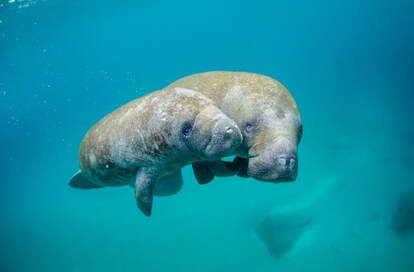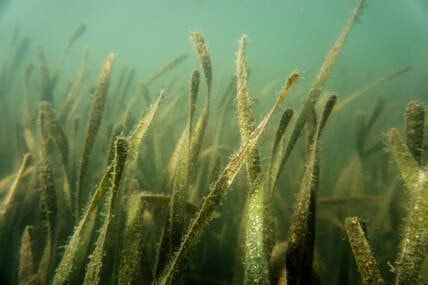Manatees in Florida feed on coastal seagrass, a species at risk from phosphorus surge
On one occasion, ironically, in Clear Water, Florida, I experienced their passive and gentle presence. Unequivocally, the nuances around their life model require hard science. But it seems like, today at least, human political divisions are being superseded by the manatee. We are putting political division aside, in order to save a remarkable species.
Fortunately, the Piney Point water that has breached its contained setting, is “treated” water. It includes only a fraction of the toxicity of countless other local Bone Valley impoundments of what’s known as “tailings water” connected with phosphate mining.
Here’s the problem: the phosphorus concentrations in this spill will not directly kill manatees, but ultimately will result in harmful algae blooms (HABs). Watch out for both cyanobacteria freshwater blooms and red tide in brackish and marine settings. These in turn will occlude sunlight from a major source of food for manatees, as in submerged seagrasses. And in some instances, the blooms will excrete toxins, which add just one more variable to the mix. Seagrasses are a vital link in the manatee’s life model. And it takes sunlight to grow seagrasses. As water becomes turbid due to algae bloom, sunlight is blocked. Seagrass diminishes, or disappears. As do the manatee. Life is resilient. And yes, there are actionable human designs that can provide forage for manatees. The designs can also supplement the warm water (above 68°F) that manatees require. Human-designed systems can provide survival forage and warm water, and perhaps help the species survive the environmental insult of millions of gallons of nutrient-impaired water inundated into their core habitat. Nature’s food web is comprehensive Manatees consume at least sixty forms of plant life. Reflective of species resilience, a number of these are shoreline plants which are not impacted by water turbidity. In fact, the nutrient load associated with water turbidity may enhance their growth. Bottom line…if sunlight can’t make it through the water, then grow survival forage above the water. This is truly just a stop-gap measure. Nature’s wetland effect will be in play. The water clarity will come back. But know that surges of nutrients will resurrect for the indefinite future. And manatees can survive periods of scarcity. After all, they have fat reserves. But providing alternative forage through such periods will help. Nature’s food web is comprehensive. Given enough time, every niche is filled with biota that competes, synergizes, and symbiotically sustains. Nature’s resilience knows no bounds. Nature is the ultimate inventor. She will plow her way through the current episode, and as long as we don’t eviscerate all options our manatees will survive, if only on a downward trend basis. Humans must partner with nature to undo damage Without a doubt, provision of the basics for survival for the manatee will help. Growing forage on floating islands that surround solar farms will do just that. And as a wonderful example of accidental synergy, the solar farms generate high volumes of waste heat. This heat combined with immediately available forage is a survival combination for the manatee population at Piney Point, and Port Manatee. Floating islands are long-term solutions. They are not the pop-a-pill solution we’ve become accustomed to over the last several dysfunctional decades. Instead, they mimic nature’s model, in which “time” figures prominently. Ultimately, floating islands biomimic nature’s model, and we can’t force nature. Instead, we must partner with nature. This means launching volumes of nature’s concentrated wetland effect, and doing so now, in order to ally with time, and ultimately, fix settings like the Bone Valley of Florida. With nature as an ally, as a partner, the nutrient-impaired water of Bone Valley will be transitioned to health. We’ve already got the start of a commercially viable solution Today it’s vital that conservation projects are affordable. There really aren’t many options. So projects that pay for themselves have a much greater chance of enactment. Human design, combined with our commercial endeavor affinity, is a terrific combination. This is how we help the manatee pull through. Floating photovoltaics (FPV) projects are gaining traction for alternative energy. But there is incredible synergy with FPV and dealing with spills with high phosphorus concentrations. Floating photovoltaics platforms can launch the food web that will compete with algae for the excess nutrients. So, here’s the solution: We launch FPV projects asap, and surround them with forage islands, across as much of the affected watershed as achievable. In fact, today’s massive volume of nutrient-impaired inventory water, as in the hundreds of impounded ponds just like the Piney Point system that just breached, are tomorrow’s Transition Water. It will be incredibly productive, and healthy, at levels that supersede anything we currently know of. I think of my own Fish Fry Lake, the first example of true Transition Water, where nutrients are cycled into desirable, beneficial forms of life. Bone Valley, and its huge volume of inventoried nutrient, is a latent opportunity to demonstrate true sustainability. And at the same time, we help the manatee survive.
1 Comment
1/16/2024 02:27:22 am
The insights in your article were invaluable. I truly appreciate the depth of information you've provided. Thank you.
Reply
Leave a Reply. |
AuthorWrite something about yourself. No need to be fancy, just an overview. Archives
August 2023
Categories
All
|


 RSS Feed
RSS Feed